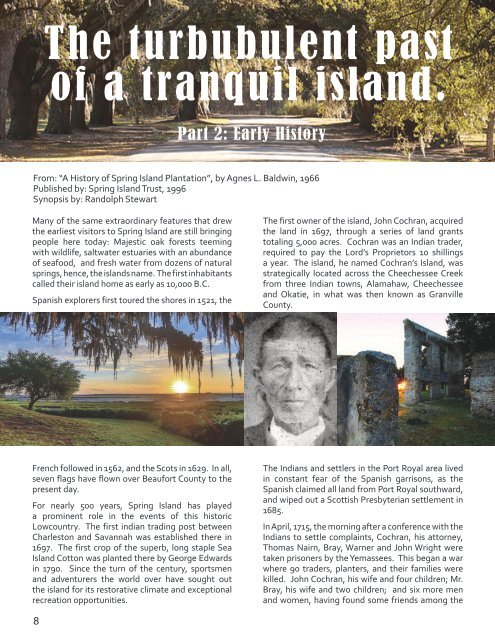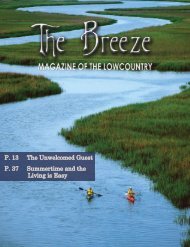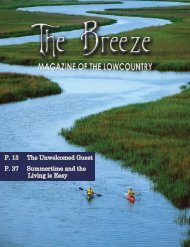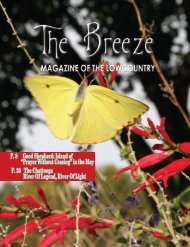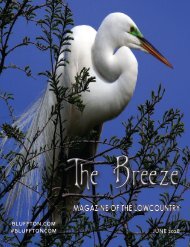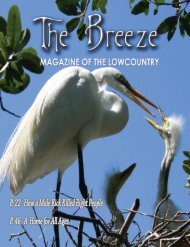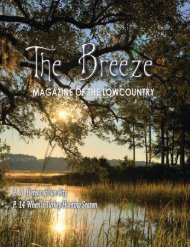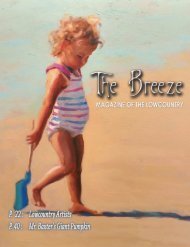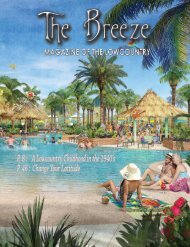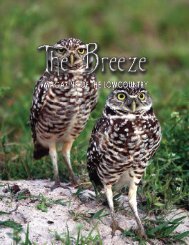You also want an ePaper? Increase the reach of your titles
YUMPU automatically turns print PDFs into web optimized ePapers that Google loves.
<strong>The</strong> turbubulent past<br />
of a tranquil island.<br />
Part 2: Early History<br />
From: “A History of Spring Island Plantation”, by Agnes L. Baldwin, 1966<br />
Published by: Spring Island Trust, 1996<br />
Synopsis by: Randolph Stewart<br />
Many of the same extraordinary features that drew<br />
the earliest visitors to Spring Island are still bringing<br />
people here today: Majestic oak forests teeming<br />
with wildlife, saltwater estuaries with an abundance<br />
of seafood, and fresh water from dozens of natural<br />
springs, hence, the islands name. <strong>The</strong> first inhabitants<br />
called their island home as early as 10,000 B.C.<br />
Spanish explorers first toured the shores in 1521, the<br />
<strong>The</strong> first owner of the island, John Cochran, acquired<br />
the land in 1697, through a series of land grants<br />
totaling 5,000 acres. Cochran was an Indian trader,<br />
required to pay the Lord’s Proprietors 10 shillings<br />
a year. <strong>The</strong> island, he named Cochran’s Island, was<br />
strategically located across the Cheechessee Creek<br />
from three Indian towns, Alamahaw, Cheechessee<br />
and Okatie, in what was then known as Granville<br />
County.<br />
French followed in 1562, and the Scots in 1629. In all,<br />
seven flags have flown over Beaufort County to the<br />
present day.<br />
For nearly 500 years, Spring Island has played<br />
a prominent role in the events of this historic<br />
Lowcountry. <strong>The</strong> first indian trading post between<br />
Charleston and Savannah was established there in<br />
1697. <strong>The</strong> first crop of the superb, long staple Sea<br />
Island Cotton was planted there by George Edwards<br />
in 1790. Since the turn of the century, sportsmen<br />
and adventurers the world over have sought out<br />
the island for its restorative climate and exceptional<br />
recreation opportunities.<br />
<strong>The</strong> Indians and settlers in the Port Royal area lived<br />
in constant fear of the Spanish garrisons, as the<br />
Spanish claimed all land from Port Royal southward,<br />
and wiped out a Scottish Presbyterian settlement in<br />
1685.<br />
In April, 1715, the morning after a conference with the<br />
Indians to settle complaints, Cochran, his attorney,<br />
Thomas Nairn, Bray, Warner and John Wright were<br />
taken prisoners by the Yemassees. This began a war<br />
where 90 traders, planters, and their families were<br />
killed. John Cochran, his wife and four children; Mr.<br />
Bray, his wife and two children; and six more men<br />
and women, having found some friends among the<br />
8


